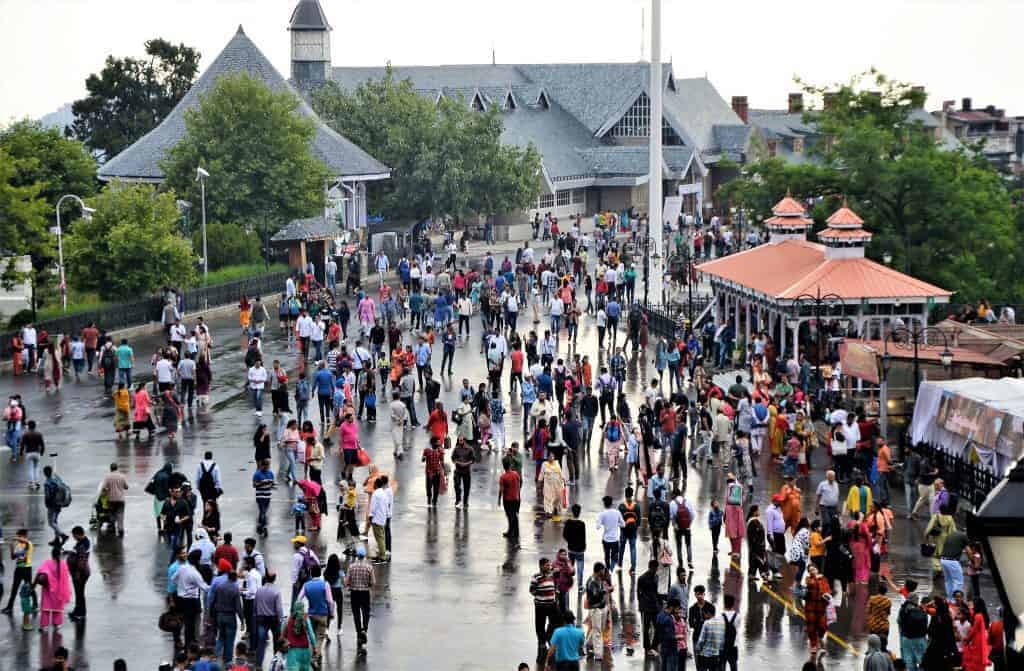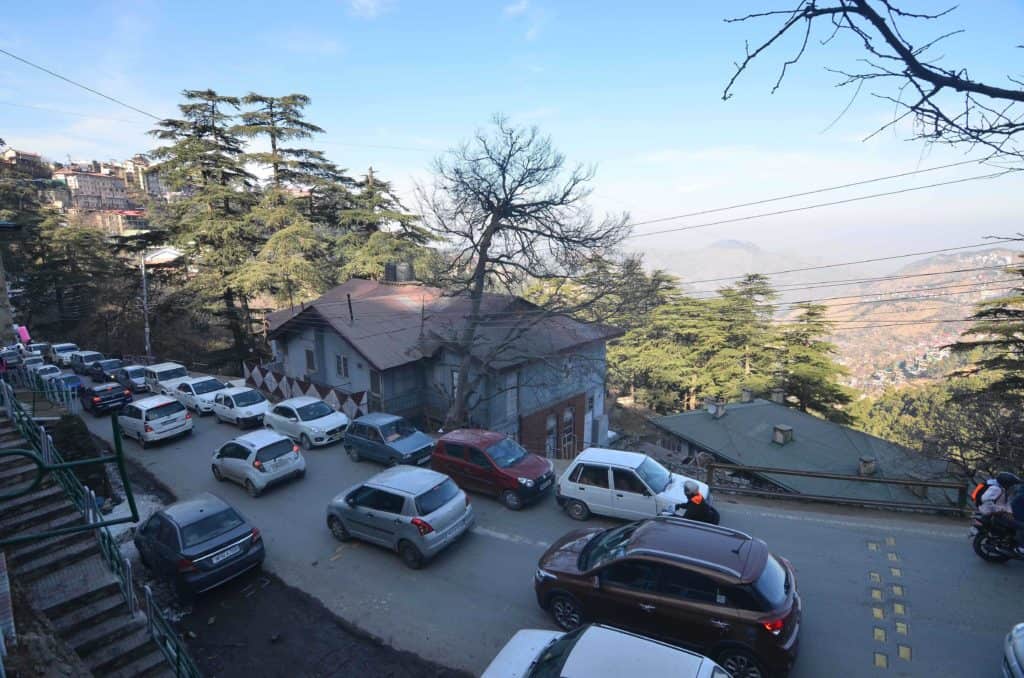“Shimla’s carrying capacity vis-à-vis vehicles is already exhausted and needs immediate solutions” admits Mohit Chawla, Superintendent of Police (SP) Shimla, as the city prepares to welcome tourists in the coming months. Having suffered huge losses last year, Shimla’s tourism-related businesses are hoping for a good season in 2021, as unlock restrictions are eased more and more.
Unfortunately, an influx of tourist vehicles from outside the state would only worsen an already chaotic hill station’s traffic woes. The town presently does not have the capacity to cope even with the existing 1.2 lakh plus registered vehicles and more than 25,000 other vehicles: buses and heavy carriage transport vehicles plying in the city and parked haphazardly on roads and narrow bylanes, which have frustrated any exercise to create a robust traffic mobility plan for the town.
From the British era of man-pulled rickshaws and manual sweeping and washing of the Mall Road, which was then meant primarily for pedestrians, to the present era of motorised transport of all kinds, Shimla’s problems have increased both in number and complexity. Today, apart from haphazard urbanisation and population explosion, the city is grappling with massive vehicular congestion, traffic chaos, rise in accidents and a massive parking problem.
Read more: Traffic jam at 13000 feet: What summer tourism means for hill towns in Himachal!
To somewhat ease this problem, the government is finally trying to put in place some innovative systems for mitigation of Shimla’s traffic woes. The Rs 2906-crore smart city project has a full chapter devoted to improving traffic mobility and sets-out comprehensive goals to free the town from congestion, during peak hours and busy tourist’s season. No details are presently available on how much of this has been received and how much has been spent on specific traffic-related projects.
“During my tenure as Mayor (and 2012-2017), we did an elaborate exercise, almost ward-wise, to prepare a City Mobility Plan (CMP) for Shimla,” said Sanjay Chauhan. “We encouraged suggestions from the public before the document was prepared, taking into account likely growth of the city till 2031. Everything was done democratically and professionally. Unfortunately, I doubt if anybody has read the document including incumbent minister for Urban development Suresh Bhardwaj, who is sitting Shimla MLA. The latest new plan has been prepared by the police, in complete isolation. I doubt if it will work.”
In 2019, Chief Minister Jai Ram Thakur told the Assembly that a committee set-up under Principal Secretary (Transport) would look into the feasibility of implementing a City Mobility Plan (CMP). The committee is yet to come-up with any follow-up action.
The problem
As per studies, the town’s inadequate road network is having to cope with numbers it was never designed to. The effective carriageway width of roads is decreasing due to the increase in business centres that have come up along the roads. This has affected traffic movement, creating bottlenecks.A Shimla Road Users and Pedestrian (Public Safety and Convenience Act) 2007 was subsequently enacted to mitigate this problem and improve pedestrians’ safety. But this plan too, like many other plans before it, remains on paper.
Designed to house a population of 30,000 people maximum, Shimla’s population today is over 2.5 lakh leading to a massive increase ownership of private vehicles. The heavy tourist influx during the peak summers and weekends negates any and all traffic mobility plans the city administration draws up. In fact, on New Year’s Day, Shimla set a single day record of 15,000 tourists vehicles entering the town, almost double the normal number.
Lack of parking space in and around schools, colleges, university campus, hospitals, government and private offices, market areas and residential localities has resulted in utter chaos. Unplanned parking on narrow hill roads all over the town has become a big hindrance to smooth vehicular mobility.
“Under these conditions, Shimla is not offering any pleasant experience to both local residents and visitors,” says Mohit Chawla. “Average journey speed has come down to 24 Kmph. Bottleneck areas such as Lakkar Bazaar has the lowest journey speed of approximately 2 Kmph during peak hours. Other congested areas like HPTDC Lift have a journey speed of 6 Kmph. Sanjouli Chowk to Dhalli tunnel is 9 Kmph to 12 Kmph.”
“Traffic mobility of any town has a direct bearing on the city life, economic activity and governance,” admits minister for Urban Development Suresh Bhardwaj. “Shimla being the capital requires a focussed attention and long-term solutions. We now do have new plans to relieve the city from its inherent problems under the Smart City project. Shimla Police has also come-out with a 72-page draft on Shimla Traffic Regulation and Management Plan (SITRAM)”.
The draft plan (released by Urban Development minister, has not yet been uploaded on the official website) suggests solutions to the town’s multiple problems with the aim of making Shimla commuter friendly. Some of these traffic management solutions have been tried out successfully in hill towns like Gangtok.
Chawla, who has worked extensively on this draft, says the focus in the plan is ensuring smooth flow of traffic, preventing accidents, helping road users in distress, safe pedestrian movement, use of technology and ‘zero tolerance’ approach against violators.
Goals outlined
Being primarily a pedestrian city, the police acknowledge the importance of all other non-motorized transport, public transport, clearing bottlenecks, improving intersections, outline existing and future road network, development of new parking facilities and use of IT solutions for peak and daily movements.
The Municipal Corporation has also worked on a plan to promote cycling on some selected tracks, while the transport department has introduced a dozen electric buses for Shimla’s circular road and peripheral colonies like New Shimla, Summerhill, Tutu, Jutogh, Bharari, Dhalli, Bhatakufer and Panthaghati.
With half a dozen projects relating to flyways, escalators and foot bridges planned under the Smart City Project, the draft also suggests the need of metro-cable and to earmark more “no parking” areas. Most of these projects, estimated to cost Rs 500 crore, are likely to be completed in 2022.
“We have also suggested shifting of the subzi mandi and grain market to the outskirts, relocating Lakkar Bazar and bus stand and moving mechanic shops, petrol pumps out of the city,” added Mohit Chawla. Shimla Police also proposes to develop artificial intelligence and smart traffic management systems.
The traffic plan seeks to revamp and reorient the entire mobility system for vehicles, including heavy carriage transport vehicles, public transport buses, tourist vehicles and private cars and freeing high density places including Shimla’s IGMC hospital from idle parking on the roads leading to the prestigious hospital.
Read more: Why Shimla smart city projects worth Rs 2905 crore look destined to fail
One advantage right now, basically due to the pandemic, is that educational institutions are closed. Pre-COVID, the town used to get choked during the morning and afternoon hours with hundreds of vehicles and school buses carrying schoolkids.
“But once schools open, we will hold meetings to ensure that fewer private vehicles are used, by encouraging students to use public transport services,” said Mohit Chawla. Besides buses, both electric and diesel, the city also has taxi service on half a dozen roads to enable women, elders and handicapped persons to reach Mall road and the Ridge, which are central Shimla ‘s market and activity area.
Question mark
But sceptics abound, like former Shimla Mayor Sanjay Chauhan. “The plan will not work without complete involvement of the community, strict action against violators, particularly VIPs and other departments like transport, Municipal Corporation and district administration,” says Chauhan. “In my earlier report, the role of every agency had been defined. It recommended construction of four tunnels to cut distance and facilitate smooth traffic on the Circular Road. But the government did nothing.”
He regrets that JNNURM project lapsed in 2012 before he took over and Shimla did not get any benefit under this flagship project. It simply became one more casualty to the politics between Congress-led Corporation and the BJP government.
Also read:

